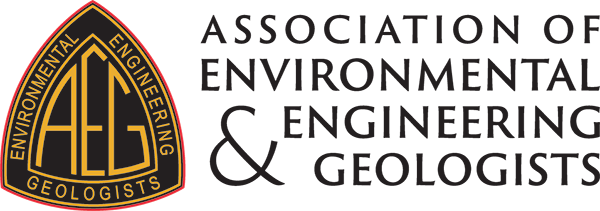Women’s History Month – American Women in the Geosciences
By: Sarah Kalika
In honor of Women’s History Month and International Women’s Day (March 8), I’m guest-authoring this column highlighting some well-known American female geologists and outstanding women of AEG’s leadership who continue to inspire us.
Pioneering Woman Geologists
Mary Emilie Holmes (1850-1906) was the first woman to be elected a fellow of the Geological Society of America. 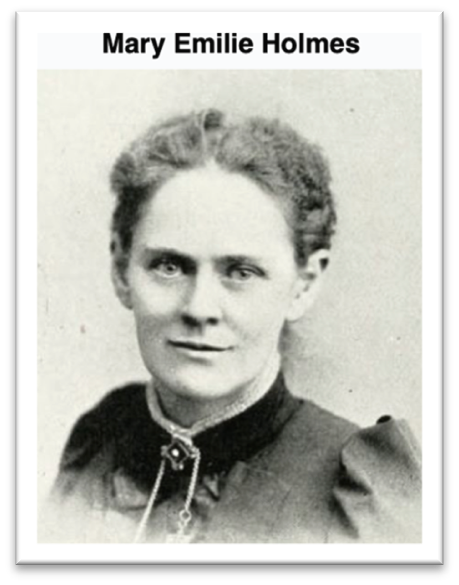 She also co-founded a seminary for young black women that evolved into Mary Holmes College, named for her mother. Holmes earned her PhD in 1888 from the University of Michigan, and was the first woman to earn a doctorate in earth science where her dissertation was on the morphology of corals. In 1892 she gave a talk before the Women’s Department of the World’s Congress Auxiliary of the World’s Columbian Exposition in Chicago, urging the importance of teaching geology to children. While she did not practice geology for very long (1885 to 1892), Holmes helped pave the way for future women to establish careers as geologists and devoted the remainder of her career to teaching.
She also co-founded a seminary for young black women that evolved into Mary Holmes College, named for her mother. Holmes earned her PhD in 1888 from the University of Michigan, and was the first woman to earn a doctorate in earth science where her dissertation was on the morphology of corals. In 1892 she gave a talk before the Women’s Department of the World’s Congress Auxiliary of the World’s Columbian Exposition in Chicago, urging the importance of teaching geology to children. While she did not practice geology for very long (1885 to 1892), Holmes helped pave the way for future women to establish careers as geologists and devoted the remainder of her career to teaching.
In 1896, Florence Bascom (1862-1945) was the first woman hired by the United States Geological Survey. In 1893, she was the second woman to earn her PhD in geology in the United States, and was the first woman to earn a degree at Johns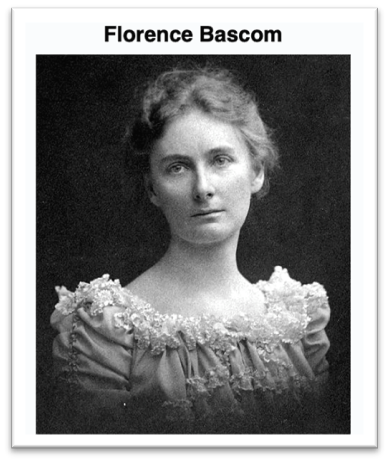 Hopkins University. As a pioneer in petrography, Bascom spent several years teaching at the Ohio State University, then went on to found the geology department at Bryn Mawr College in Pennsylvania in 1895. Bascom’s mapping and study of thin sections collected from schists and gneisses of the Piedmont (Maryland, Pennsylvania, and New Jersey) led to much clarification of the complicated geology of that area. By 1924, Bascom became a councilor of the Geological Society of America (GSA) and in 1930 was appointed as vice-president of the society, as the first woman to hold those offices. Florence Bascom inspired and taught a generation of young women geologists. In 1937, eight of the eleven woman fellows of GSA were graduates of Bascom’s course at Bryn Mawr College.
Hopkins University. As a pioneer in petrography, Bascom spent several years teaching at the Ohio State University, then went on to found the geology department at Bryn Mawr College in Pennsylvania in 1895. Bascom’s mapping and study of thin sections collected from schists and gneisses of the Piedmont (Maryland, Pennsylvania, and New Jersey) led to much clarification of the complicated geology of that area. By 1924, Bascom became a councilor of the Geological Society of America (GSA) and in 1930 was appointed as vice-president of the society, as the first woman to hold those offices. Florence Bascom inspired and taught a generation of young women geologists. In 1937, eight of the eleven woman fellows of GSA were graduates of Bascom’s course at Bryn Mawr College.
Marguerite Thomas Williams (1895-1991) was the first African American to earn a PhD in geology in the United States. 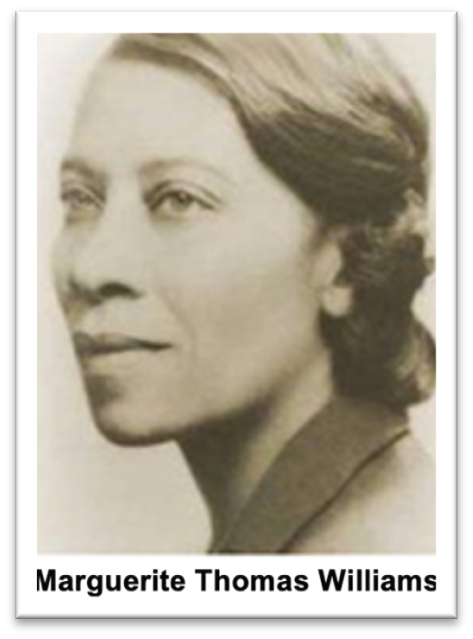 She earned her degree from Catholic University of America in Washington, D.C. with her dissertation, The History of Erosion in the Anacostia Drainage Basin in 1942. Williams spent most of her career teaching geology courses and from 1923-1933 she was the Chair of the Division of Geography at the University of the District of Columbia. She additionally taught at Howard University during the 1940’s and retired in 1955.
She earned her degree from Catholic University of America in Washington, D.C. with her dissertation, The History of Erosion in the Anacostia Drainage Basin in 1942. Williams spent most of her career teaching geology courses and from 1923-1933 she was the Chair of the Division of Geography at the University of the District of Columbia. She additionally taught at Howard University during the 1940’s and retired in 1955.
Even with the incredible teaching, leadership, and mentorship of Holmes, Bascom, Williams, and others, women were slow to enter the field of geology in part because while women were allowed to study geology and teach on the university level, field work was considered “too dangerous.” It wasn’t until 1964 (one year after AEG was officially incorporated) that the first women, Cynthia Avery, Rosalind Tuthill, and Judy Terry, were enrolled in the summer field program at Stanford University. Back then, women were unable to enter a tunnel or go underground in mines- for fear that they would bring bad luck, causing the mine or tunnel to collapse
to enter the field of geology in part because while women were allowed to study geology and teach on the university level, field work was considered “too dangerous.” It wasn’t until 1964 (one year after AEG was officially incorporated) that the first women, Cynthia Avery, Rosalind Tuthill, and Judy Terry, were enrolled in the summer field program at Stanford University. Back then, women were unable to enter a tunnel or go underground in mines- for fear that they would bring bad luck, causing the mine or tunnel to collapse
Marie Tharp (1920-2006) completed a Masters Degree in petroleum geology at the University of Michigan at  Ann Arbor. She took a job at an oil company in Oklahoma, but at the time, women were not allowed to go on field trips to look for oil and gas. Her duties in the office were to collect maps and data. She soon left Oklahoma and moved to New York City, where she found drafting work at the Lamont Doherty Observatory and worked with Bruce Heezen on plotting the ocean floor. In 1968, Tharp used data collected from the Woods Hole Oceanographic Institution’s ship Atlantis and seismographic data from undersea earthquakes to complete the first attempt to map the ocean floor, which led to her discovery of the Mid-Atlantic Ridge. She served on the faculty at Columbia University until 1983, when she retired and operated a map distribution business. She has been posthumously recognized by Google Earth, various children’s books, and in an episode of Neil deGrasse Tyson’s Cosmos: A Spacetime Odyssey. In 2015, the International Astronomical Union named the Tharp Moon crater in her honor.
Ann Arbor. She took a job at an oil company in Oklahoma, but at the time, women were not allowed to go on field trips to look for oil and gas. Her duties in the office were to collect maps and data. She soon left Oklahoma and moved to New York City, where she found drafting work at the Lamont Doherty Observatory and worked with Bruce Heezen on plotting the ocean floor. In 1968, Tharp used data collected from the Woods Hole Oceanographic Institution’s ship Atlantis and seismographic data from undersea earthquakes to complete the first attempt to map the ocean floor, which led to her discovery of the Mid-Atlantic Ridge. She served on the faculty at Columbia University until 1983, when she retired and operated a map distribution business. She has been posthumously recognized by Google Earth, various children’s books, and in an episode of Neil deGrasse Tyson’s Cosmos: A Spacetime Odyssey. In 2015, the International Astronomical Union named the Tharp Moon crater in her honor.
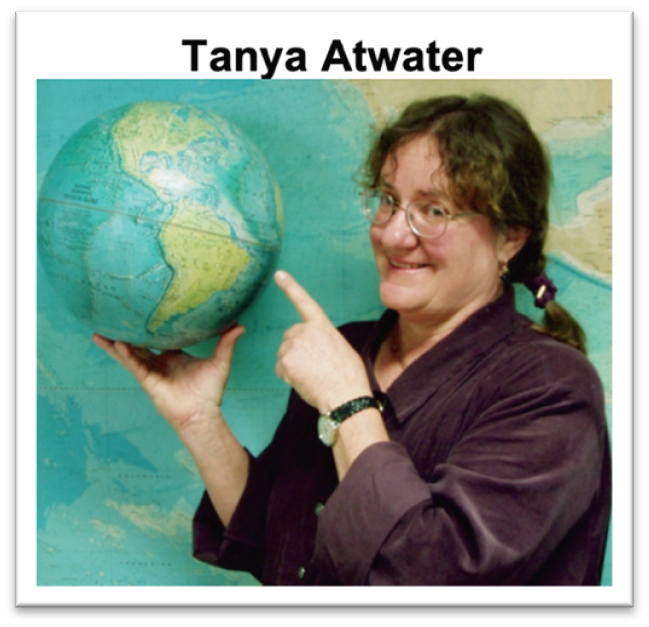
Tanya Atwater, notable expert in the plate tectonic history of western North America, earned her BA in geophysics from UC Berkeley and PhD in marine geophysics from Scripps Institution of Oceanography at UC San Diego. As a professor of plate tectonics at UC Santa Barbara (1980-2007), she had a profound impact on geology students with her incredible skill of using various means of communication, including animation technology, to illustrate the mechanisms of tectonic movement. In 1968, she co-authored a research paper Changes in Direction of Sea Floor Spreading which was published in the journal Nature and identified the faulted nature of ocean floor spreading centers. She is best known for her research and published papers on propagating rifts near the Galapagos Islands and the history of the San Andreas fault system. Her research and animation work illustrate her explanation that 40 million years ago, when the Farallon Plate was subducting beneath the North American and Pacific Plates, the lower half was entirely subducted beneath Central and Southern California, but the upper half of the plate did not sink and became the Juan de Fuca plate, with the San Andreas Fault forming a major plate boundary between the Pacific and North American Plates. The Channel Islands and Santa Ynez mountains rotated due to the northward pull of the Pacific half of the San Andreas fault. Atwater became a fellow of the American Geophysical Union in 1975, received the AAAS Newcomb Cleveland Prize for top research article in the journal Science in 1980, was elected to the National Academy of Sciences in 1997, received the National Science Foundation Director’s Award for Distinguished Teaching Scholars in 2002 – with which she created the UCSB Educational Multimedia Visualization Center, and the Penrose Medal from GSA in 2019, as well as numerous awards for teaching and mentorship.
 Dawn Wright, geographer and oceanographer, earned her BS from Wheaton College, MS in oceanography from Texas A&M, and PhD in physical geography and marine geology from UC Santa Barbara. Wright has been a professor of geography and oceanography at Oregon State sine 1995 and was the first African-American woman to dive to the ocean floor in the deep submersible ALVIN. She is currently the Chief Scientist of the Environmental Systems Research Institute (ESRI) and played a key role in creating the first GIS data model for oceans.
Dawn Wright, geographer and oceanographer, earned her BS from Wheaton College, MS in oceanography from Texas A&M, and PhD in physical geography and marine geology from UC Santa Barbara. Wright has been a professor of geography and oceanography at Oregon State sine 1995 and was the first African-American woman to dive to the ocean floor in the deep submersible ALVIN. She is currently the Chief Scientist of the Environmental Systems Research Institute (ESRI) and played a key role in creating the first GIS data model for oceans.
Jessica Watkins, NASA astronaut, will be the first Black woman to complete a long-term mission on the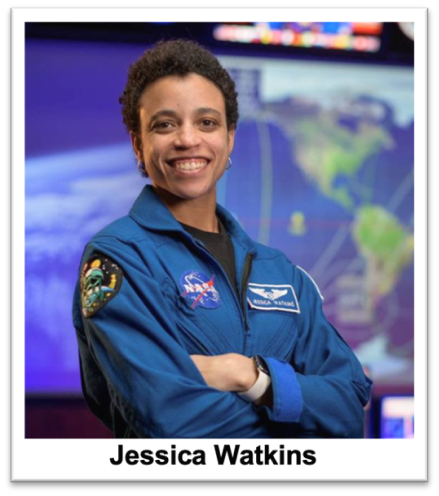 International Space Station. Her crew launch is scheduled for April 2022. Watkins earned her BS in geological and environmental sciences from Stanford University and completed her PhD at UC Los Angeles. She worked as an intern at the NASA Ames Research Center and Jet Propulsion Laboratory, studying landslides on Mars. After completing her PhD, she worked as a post-doctoral fellow at the California Institute of Technology and was a member of the science team that worked on planning missions for NASA’s Curiosity Rover. She has additionally been selected to join NASA’s Artemis team, who will be the first to step on the moon since the Apollo missions over 50 years ago. Upon completion of that mission, she will be the first woman and person of color to reach the moon.
International Space Station. Her crew launch is scheduled for April 2022. Watkins earned her BS in geological and environmental sciences from Stanford University and completed her PhD at UC Los Angeles. She worked as an intern at the NASA Ames Research Center and Jet Propulsion Laboratory, studying landslides on Mars. After completing her PhD, she worked as a post-doctoral fellow at the California Institute of Technology and was a member of the science team that worked on planning missions for NASA’s Curiosity Rover. She has additionally been selected to join NASA’s Artemis team, who will be the first to step on the moon since the Apollo missions over 50 years ago. Upon completion of that mission, she will be the first woman and person of color to reach the moon.
Women Geoscientists in National Leadership
In 2016, geophysicist Marcia McNutt was appointed President of the National Academy of Sciences. She previously served as editor-in-chief of the  journal Nature (2013-2016), and was the first woman director of the United States Geological Survey, as well as science advisor to the United States Secretary of the Interior. She earned her PhD in earth sciences from the Scripps Institution of Oceanography in 1978 with her dissertation titled Continental and Oceanic Isostasy. She was also a professor of marine geophysics at the Stanford University School of Earth Sciences and professor at UC Santa Cruz.
journal Nature (2013-2016), and was the first woman director of the United States Geological Survey, as well as science advisor to the United States Secretary of the Interior. She earned her PhD in earth sciences from the Scripps Institution of Oceanography in 1978 with her dissertation titled Continental and Oceanic Isostasy. She was also a professor of marine geophysics at the Stanford University School of Earth Sciences and professor at UC Santa Cruz.
Women in AEG’s Leadership History

Based on the results of the recent AEG demographics survey, women comprise 28% of AEG’s membership. We have had 6 incredible women serve as Association Presidents in our 64-year history. Our first woman President, Mavis Kent, led the Association in 1991, which is incidentally the same year Doris Malkin Curtis became the first woman to lead GSA. AEG continued to elect women into the Executive Council and promote women into leadership roles within the Association. Susan Steele Weir served as AEG President in 1996 and Dorian Kuper was President in 2008. In 2012, Jennifer Bauer became AEG’s youngest woman President. In 2020, Cynthia Palomares served AEG as President, patiently and skillfully guiding the Association through a global pandemic. In 2021 and 2022, there were three women in the EC and we currently have our second woman President in three years, Maddie German, leading AEG. Two additional women (Sarah Kalika and Renee Wawczak) are in the Executive Council, in line for
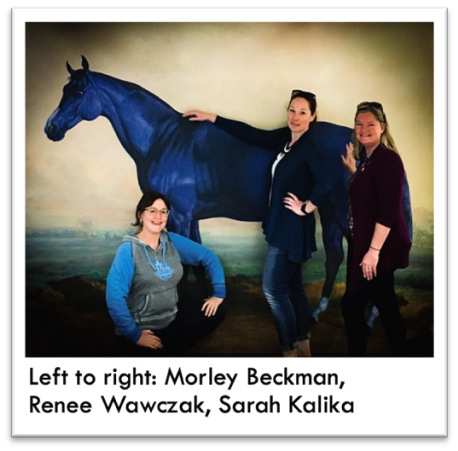 AEG President in the next few years. See a previous BlogPost celebrating our Woman AEG Presidents. Many more hardworking women are volunteering countless hours serving as Chapter leaders, Regional Directors, and chairing Operational Committees, Technical Working Groups, and Annual Meetings.
AEG President in the next few years. See a previous BlogPost celebrating our Woman AEG Presidents. Many more hardworking women are volunteering countless hours serving as Chapter leaders, Regional Directors, and chairing Operational Committees, Technical Working Groups, and Annual Meetings.
We wouldn’t be able to accomplish the goals outlined within our Strategic Plan without the support of our fantastic leaders and members.
Geology is a career path for everyone. AEG is an inclusive association for all geologists. While celebrating those who paved our way, we continue to work to inspire the future by creating an inclusive culture and combatting unconscious biases that often hold back women, and people of color, from advancing their careers or participating in leadership roles. This Women’s History Month, join us in recognizing the accomplishments of women in the geosciences and our work to inspire future generations.
"Only when diverse perspectives are included, respected, and valued can we start to get a full picture of the world." -Brene Brown
